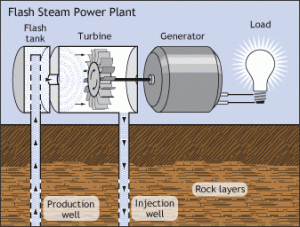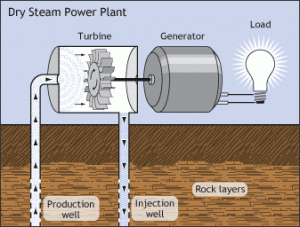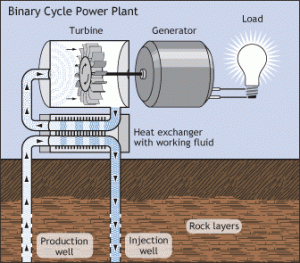There are three types of geothermal power plants.
All of the variations of geothermal power plants require wells to be drilled into the earth, miles deep to access reservoirs of hot water. This hot water or steam is used to spin turbines which generate electricity.
Flash Steam
In a flash steam power plant, extremely hot water flows up through the wells via the pressure gradient created by the temperature difference between the earth’s surface and the underground reservoir. As it travels through the wells, the some of the water turns to steam that can be separated from the liquid water and used to power a steam turbine. This is the most common type of geothermal power plant.
Dry Steam
Dry steam power plants only utilize the vaporized steam from the wells drilled into the earth. This steam is pumped up from underground to directly power turbines. Since underground steam resources are more rare than hot water resources, dry steam power plants are less common than flash steam plants.
Binary Steam
Binary geothermal power plants are able to operate at lower temperatures because the fluid powering the turbines has a lower boiling point to vaporize the fluid. Heat from underground wells is used to boil another fluid at a lower temperature in a heat exchanger that subsequently powers a turbine.
Primary Author: Allison Scoular
Edited by: Jessica Ross
Sources:
“Geothermal Energy Basics.” NREL: Learning About Renewable Energy. U.S. Department of Energy, Office of Energy Efficiency and Renewable Energy, 30 May 2012. Web. 10 Apr. 2014. <http://www.nrel.gov/learning/re_geothermal.html>.
Diagrams are from:
Heid, Mae. “How Geothermal Energy Works.” Clean Energy. Union of Concerned ScienTsts, 16 Dec. 2009. Web. 14 Apr. 2014. <hep://www.ucsusa.org/ clean_energy/our- energy-choices/ renewable-energy/how- geothermal-energy- works.html>.



